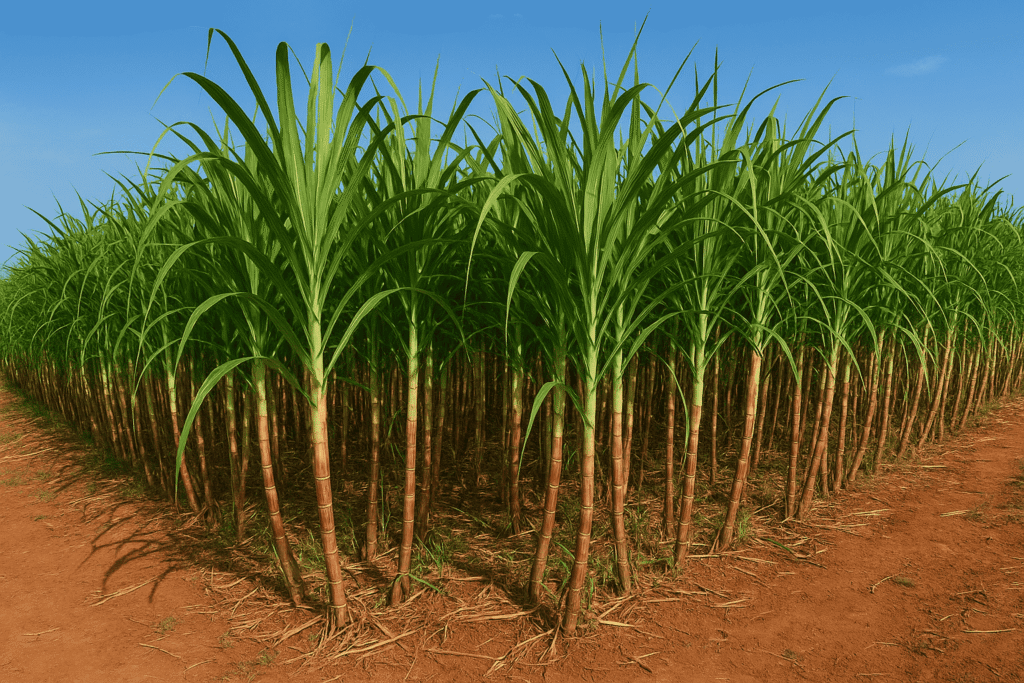Introduction
Sugarcane is one of the most important cash crops in Pakistan, primarily grown for sugar production and by-products like ethanol, molasses, and bagasse. As the backbone of the sugar industry in Pakistan, sugarcane supports over 1.5 million farming families and fuels nearly 90 operational sugar mills across the country.
Despite its potential, sugarcane in Pakistan faces numerous agronomic and policy challenges, affecting both productivity and farmer profitability. This article provides an in-depth look into sugarcane production, agronomic practices, diseases, economic value, and the way forward.
Major Sugarcane Growing Areas in Pakistan
Sugarcane is grown across all four provinces of Pakistan, but the top-producing regions include:
- Punjab: Sargodha, Faisalabad, Jhang, and Rahim Yar Khan
- Sindh: Hyderabad, Nawabshah, and Thatta
- Khyber Pakhtunkhwa (KP): Dera Ismail Khan, Charsadda, and Mardan
Punjab contributes nearly 65% of the total sugarcane output due to better irrigation, landholding, and market accessibility.
Recommended Varieties for Sugarcane in Pakistan
To improve sugarcane yield in Pakistan, the following high-yielding and disease-resistant varieties are commonly used:
- CPF-246
- CPF-247
- HSF-240
- Thatta-10
- S2003-US-633
These varieties offer higher sucrose recovery, are ratoon-friendly, and perform well under flood irrigation systems.
Agronomic Practices for Sugarcane in Pakistan
Proper agronomic management significantly boosts sugarcane yield. Recommended practices include:
1. Land Preparation
- Deep plowing (2–3 times)
- Laser leveling for uniform irrigation
- Application of well-rotted FYM (farmyard manure)
2. Sowing Time
- Spring planting: February to March
- Autumn planting: September to October (more ratoon cycles)
3. Seed Rate and Method
- 50,000 to 60,000 two-budded sets per acre
- Trench planting is preferred over flat sowing for better root development
4. Fertilizer Use
- Apply 2 bags DAP + 2 bags Urea + 1 bag SOP per acre
- Split nitrogen applications: ⅓ at sowing, ⅓ at tillering, ⅓ at elongation
(🔗 Guide to Fertilizer Use in Pakistan)
Water and Irrigation Management
Sugarcane is a water-intensive crop, requiring up to 60–70 acre-inches of water per growing season. Efficient irrigation systems like furrow and drip irrigation help reduce water waste. Waterlogging must be avoided as it promotes fungal diseases and reduces plant vigor.
Major Diseases and Pests of Sugarcane
Common Diseases:
- Red Rot (Colletotrichum falcatum): Controlled by disease-free seed and crop rotation
- Smut (Ustilago scitaminea): Use hot water-treated seed
- Pokkah Boeng: Remove infected shoots and spray fungicide
Major Pests:
- Root Borer
- Top Borer
- Pyrilla
- White Grub
Integrated Pest Management (IPM) combining biological control and selective insecticides is essential. FAO Pest Management Resources can be consulted for international strategies.
Ratoon Management for Higher Productivity
Ratoon cropping (growing sugarcane from the stubble of a previous crop) reduces cost by 25–30%. To ensure successful ratoon crops:
- Apply ½ bag Urea per acre immediately after harvesting
- Control borers and apply fungicides
- Provide a light irrigation and trash mulching
- Avoid mechanical damage to roots during harvest
Sugar Industry and Value Chain in Pakistan
The sugar industry in Pakistan is the second-largest agro-industry after textiles. Around 90 sugar mills are operational, mostly located near growing zones to minimize transportation loss.
By-products of Sugarcane:
- Bagasse: Used for biomass power generation
- Molasses: Fermented into ethanol for export
- Filter Cake: Used as an organic fertilizer
Sugarcane also supports rural employment in cutting, loading, transport, and factory labor.
Challenges Faced by Sugarcane Sector in Pakistan
- Delayed Payments: Farmers often face months-long delays from sugar mills
- Price Fluctuations: Government support prices are not always implemented
- Water Scarcity: Over-irrigation and canal mismanagement
- Pest Infestations: Limited extension services and poor scouting
- Low Mechanization: Manual harvesting dominates
Solutions and Way Forward
- Promote certified seed varieties and ratoon management
- Strengthen provincial extension services for training and IPM
- Introduce mechanized harvesting and drip irrigation support
- Ensure timely payments through sugar mill regulation
- Expand sugarcane ethanol industry for export
Conclusion
Sugarcane in Pakistan plays a pivotal role in agricultural GDP, rural employment, and industrial outputs. With better agronomic practices, improved variety adoption, water management, and fair trade practices, sugarcane can become a more profitable and sustainable crop for Pakistani farmers.
